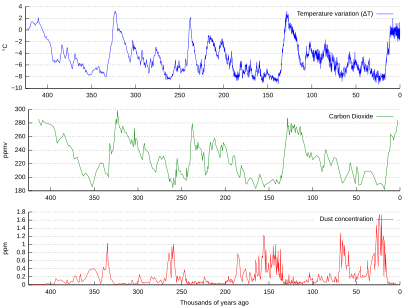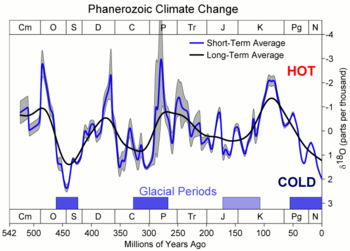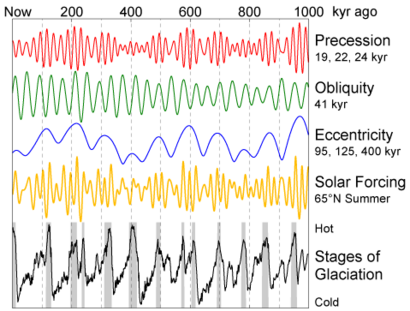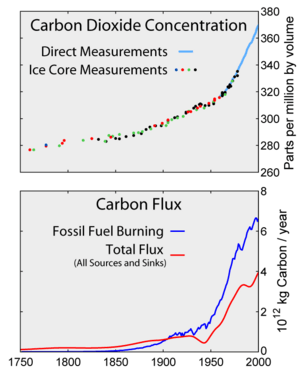Quaternary glaciation facts for kids

The Quaternary glaciation is a long period of Earth's history with many ice ages. It started about 2.58 million years ago and is still happening today. During this time, Earth has gone through cycles of very cold periods, called glacial periods, and warmer periods, called interglacial periods. Even though we are currently in a warm interglacial period, geologists still consider us to be in the Quaternary glaciation because large ice sheets still exist at the North and South Poles.
During the cold glacial periods, huge ice sheets grew and covered large parts of the continents. In the warmer interglacial periods, these ice sheets melted back. Today, only the Antarctic and Greenland ice sheets remain from the last big ice age. The Quaternary glaciation has dramatically changed Earth's surface. It has carved out land, moved huge amounts of rock and soil, changed river systems, and created millions of lakes. It also caused big changes in sea level and affected winds and ocean currents.
Contents
Discovering the Ice Ages
Scientists first started to understand the idea of ice ages in the 1700s and 1800s. Over the last 100 years, many geologists have explored Europe, North America, and Siberia. They found lots of evidence that huge glaciers once covered these areas.
Geologists created maps showing features left behind by glaciers. These features include drumlins (small hills), eskers (long ridges), moraines (piles of rock and dirt), and striations (scratches on rocks). By studying these clues, scientists could figure out how far the ice sheets spread and which way they moved. They also learned that the ice advanced and retreated many times, not just once.
What Is an Ice Age?

For geologists, an "ice age" means there are large amounts of ice on land. Before the Quaternary glaciation, Earth had at least four other major ice ages. These happened millions of years ago.
Within the Quaternary ice age, the amount of land ice, sea level, and global temperatures kept changing. During the coldest times, called glacial periods, ice sheets up to 4 kilometers (2.5 miles) thick covered parts of Europe, North America, and Siberia. The shorter warm times between these cold periods are called interglacials. We know about these warm periods from layers of old soil, peat, and lake deposits found between the rocky debris left by glaciers.
The length of these cold and warm cycles changed over time. At first, a cycle lasted about 41,000 years. But about 1 million years ago, it slowed down to about 100,000 years. We can see this clearly in ice cores, which are like frozen timelines of Earth's climate. Over the last 740,000 years, there have been eight major glacial cycles.
The entire Quaternary period, which began 2.58 million years ago, is called an ice age because at least one large ice sheet, the Antarctic ice sheet, has always been there. Currently, Earth is in an interglacial period called the Holocene. This period started about 10,000 to 15,000 years ago. During this time, the ice sheets from the Last Glacial Period have slowly melted. Today, glaciers cover about 10% of Earth's land, mainly in Greenland, Antarctica, and some mountains. During the glacial periods, sea levels were about 120 meters (390 feet) lower than they are now because so much water was locked up in ice.
Why Do Ice Ages Happen?
Earth's climate changes due to two main things: internal changes within Earth's own climate system (like ocean currents and the carbon cycle), and external forces from outside the climate system (like changes in Earth's orbit, volcanism, and the Sun's energy).
Earth's Orbit and Tilt
The idea that changes in Earth's orbit affect climate was first suggested by James Croll in the 1800s. Later, a Serbian scientist named Milutin Milanković developed this idea further. He calculated that small, regular changes in Earth's orbit could cause the climate cycles we now call Milankovitch cycles.
These cycles are caused by three main changes in Earth's path around the Sun:
- Shape of Orbit (Eccentricity): Earth's orbit around the Sun changes from nearly circular to slightly oval over about 100,000 years.
- Tilt of Axis (Obliquity): Earth's axis is tilted, which causes the seasons. This tilt changes slightly (between 22° and 24.5°) over about 41,000 years. A greater tilt means more extreme seasons.
- Wobble of Axis (Precession): Earth's axis also wobbles like a spinning top, completing a cycle every 26,000 years.
These factors change how much sunlight different parts of Earth receive during different seasons. They don't change the total amount of sunlight Earth gets each year. Instead, they change the contrast between summer and winter. When summers are cooler, less ice melts, allowing glaciers to grow. Scientists have studied deep-sea cores and found that climate changes over the last few hundred thousand years match Milankovitch's predictions very well.
Changes in Air Composition
One idea is that a decrease in carbon dioxide (CO2) in the atmosphere helped start the long-term cooling trend. CO2 is an important greenhouse gas that traps heat. Evidence from rocks shows that atmospheric CO2 has dropped by more than 90% since the middle of the Mesozoic Era. This drop in CO2 likely played a big role in the formation of ice sheets in the Arctic and Antarctic.
CO2 levels also change between warm interglacial periods and cold glacial periods. High CO2 levels match warm periods, and low CO2 levels match cold periods. However, scientists think that CO2 might not be the main cause of these changes, but rather acts as a feedback that makes the changes stronger.
Moving Continents and Ocean Currents

The positions of the continents play a big role in long-term ice ages. They control how ocean currents and winds move heat around the planet. For most of Earth's history, the North Pole was in a wide-open ocean. This allowed warm ocean currents to flow into the polar regions, keeping them mild.
But during the Cenozoic Era, the North and South American continents moved west. This created the Atlantic Ocean and put the North Pole in the small, almost landlocked Arctic Ocean. Also, about 33.9 million years ago, the Drake Passage opened, separating Antarctica from South America. This allowed the Antarctic Circumpolar Current to flow around Antarctica, isolating it from warm waters and helping its huge ice sheets form.
Later, about 2.6 million years ago, the Isthmus of Panama formed, connecting North and South America. This blocked the flow of water between the Pacific and Atlantic Oceans. This change in ocean currents brought more warm, salty water to the Arctic, providing enough moisture for glaciers to start forming in the Northern Hemisphere.
Rising Mountains
The uplift of continents, especially the formation of mountains, also helped cause the Quaternary glaciation. As Earth's landmasses moved away from the tropics and more mountains formed, there was more land at high altitudes and high latitudes. This favors the growth of glaciers. For example, the Greenland ice sheet formed as the land in Greenland rose about 10 and 5 million years ago. Computer models show that these rising mountains would have led to more snow and cooler temperatures, helping glaciers grow.
Effects of the Ice Ages
The huge amount of ice on the continents had a massive impact on Earth's water systems. The most obvious effects are the amazing mountain scenery and other landscapes shaped by glaciers. Entirely new landscapes covering millions of square kilometers were formed quite quickly in geological terms. The glaciers also affected areas far from their edges, directly or indirectly changing every part of the world.
Lakes
The Quaternary glaciation created more lakes than all other geological processes combined. This happened because glaciers completely changed old river systems. The ice scoured and eroded the land it moved over, leaving many closed hollows in the bedrock. These hollows filled with water and became lakes.
Very large lakes also formed along the edges of the glaciers. The ice in North America and Europe was about 3,000 meters (9,800 feet) thick at its center. The weight of this ice pushed the Earth's crust down. As the ice melted, the land slowly rose back up, but it lagged behind the melting. This created basins that filled with water. The Baltic Sea and the Great Lakes of North America formed mainly in this way.
Many lakes in Canada, Sweden, and Finland are also thought to have formed partly from glaciers eroding weathered rock.
Pluvial Lakes
The same climate conditions that caused glaciers also affected dry and semi-dry regions far from the ice sheets. The increased rainfall that fed the glaciers also caused major rivers and streams to swell. This led to the growth of large pluvial lakes. Most pluvial lakes formed in dry areas where there wasn't usually enough rain for rivers to reach the sea. Instead, water flowed into closed basins, forming temporary lakes. With more rain, these lakes grew and sometimes overflowed. Pluvial lakes were largest during glacial periods and shrank to small salt flats during warmer interglacial times.
Land Rebound
The massive weight of the ice sheets pushed down the continents. This caused major isostatic adjustments of Earth's crust. In Canada, a large area around Hudson Bay sank below modern sea level, as did the area around the Baltic Sea in Europe. Since the ice melted, the land has been slowly rising back up. Some of these movements even caused large earthquakes in Scandinavia about 9,000 years ago.
Studies show that this uplift happened in two stages. First, there was a rapid "elastic" rebound as the ice melted. After that, the uplift slowed down, continuing at about 1 centimeter (0.4 inches) per year or less today. In some parts of Alaska, it's even faster, about 2.54 centimeters (1 inch) per year. Scientists believe the land will continue to rise for at least another 10,000 years.
Winds
The presence of so much ice greatly changed how air moved around the planet. Winds near the glacier edges were very strong and constant because of the dense, cold air coming off the ice fields. These winds picked up and carried huge amounts of loose, fine-grained sediment left by the glaciers. This dust settled as loess (wind-blown silt), forming thick blankets over areas like the Missouri River valley, central Europe, and northern China.
Sand dunes were also much more common and active in many areas during the early Quaternary period. For example, the Sand Hills region in Nebraska was a large, active dune field during the Pleistocene epoch. Today, it is mostly covered and stabilized by grass.
Ocean Currents
Some very thick glaciers were heavy enough to reach the sea bottom in important areas. This blocked the flow of ocean water and changed ocean currents. These changes in ocean currents also had a feedback effect, influencing how heat was transferred around the globe.
Past Ice Ages
Glaciation has been rare in Earth's long history. However, there is evidence of widespread glaciation during the late Paleozoic Era (300 to 200 million years ago) and the late Precambrian (800 to 600 million years ago). Before the current ice age, which began 2 to 3 million years ago, Earth's climate was usually mild and stable for very long periods. We know this from the types of fossil plants and animals found in rock layers.
One of the best examples of a pre-Quaternary ice age is the Karoo Ice Age. Evidence for it is found in rocks from the late Paleozoic in South Africa, India, South America, Antarctica, and Australia. There are also signs of even older glacial sediments on every continent except South America. These show that two other major periods of widespread glaciation happened during the late Precambrian, leading to what scientists call "Snowball Earth" during the Cryogenian period.
When Is the Next Ice Age?
The warming trend that followed the Last Glacial Maximum (the peak of the last ice age), which started about 20,000 years ago, caused sea levels to rise by about 130 meters (427 feet). This warming slowed down about 6,000 years ago, and sea levels have been quite stable since then. Our current warm period, the Holocene climatic optimum, has been unusually stable and warm compared to previous interglacials. This stability might have helped human civilization develop.
Based on models of Earth's orbit, the cooling trend that began about 6,000 years ago should continue for another 23,000 years. However, some scientists suggest that even without human influence, the next glacial period might not start for another 50,000 years due to slight changes in Earth's orbit.
It is also possible that the current cooling trend could be interrupted by a warmer phase in about 60,000 years, with the next glacial maximum only arriving in about 100,000 years.
In the 1970s, some people worried that the next ice age was coming soon. This was based on past interglacial periods lasting about 10,000 years. However, newer models suggest a much longer warm period, possibly lasting another 50,000 years. More importantly, human activities are now seen as possibly extending this warm period even further. The timing of the next glacial maximum depends a lot on the amount of carbon dioxide in the atmosphere. Studies suggest that the heat-trapping gases we release into the atmosphere and oceans will likely prevent the next ice age, which would otherwise begin in about 50,000 years, and possibly even more glacial cycles after that.




